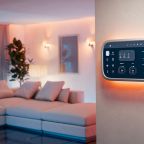
Cloud vs. Local - Choosing the Right Smart Home Hub
At a fundamental level, smart home hubs are designed to work in the same way. They combine a variety of connected smart devices with a central hub, which in turn controls that features and functions.
There are two very different approaches to setting up a smart home lighting hub, with their own unique pros and cons. These two options are cloud-managed and locally-managed hubs - both of which are straightforward to set up.
Figuring out which of the two is best for you may seem tricky, but can be simplified by considering their potential benefits and drawbacks.
Locally-Managed Smart Hubs
A locally-managed hub is a system that exists 100% on-site in a fully physical capacity. This is where everything you need to control your smart devices is integrated into your home, with no reliance on external connections, providers or services.
No external internet connection (or outside connection of any kind) is required for the system to work.
Anatomy of Locally-Managed Automation
A basic overview of the mechanics of a locally-managed home automation system would be as follows:
- A motion detector picks up movement somewhere around the home
- The motion detector sends a message to the hub to take action
- The hub then activates the light or triggers an alarm automatically
Simple yet effective, this is the way most high-end smart home automation systems currently work.
Benefits of Locally-Managed Smart Home Hubs
- Simplicity - the system is easier to set up and run as everything is contained on-site
- Reliability - no chance of a system error or outage due to network or Internet issues
- Privacy - none of your private information or sensitive data is transmitted externally
- Security - the system cannot be hacked into from outside parties for illicit purposes
Drawbacks of Locally-Managed Smart Home Hubs
- Costs - more powerful/sophisticated hardware is needed to operate the system
- Support - no external support provided in case of errors or difficulties faced
Cloud-Managed Smart Hubs
This type of smart home hub has been around for a decade now, and has made its way into millions of homes and businesses. This is where the system you install in your home connects with an external server, which forms the ‘brain’ of the home’s smart automation system.
Brands like SmartThings, Revolv and Wink continue to lead the field in cloud-managed smart home automation, but new providers are joining the mix all the time.
Anatomy of Cloud-Managed Automation
All brands have their own unique approach to cloud-managed smart home automation, but the basic mechanics of how the system works is always the same:
- A motion detector picks up movement somewhere around the home
- The information is sent to the hub and forwarded to a central cloud server
- The cloud-based server determines the appropriate response
- The hub downloads the information from the central cloud server
- The light or alarm is then activated by the hub as required
This is a slightly more complex approach which comes with its own benefits and drawbacks to consider.
Benefits of Cloud-Managed Smart Home Hubs
- Costs - initial hardware purchase costs may be slightly lower with cloud systems
- Support - advice and input when required from the service provider’s support team
Drawbacks of Cloud-Managed Smart Home Hub
- Speed - an inevitable degree of latency due to the additional processing required
- Reliability - the system may be rendered inoperable due to an Internet outage
- Privacy - sensitive private information transmitted regularly and stored online
Which is the Clear Winner?
Truth is, determining which of the two is ‘best’ means establishing your preferences and priorities.
If reliability and performance matter most, opting for a locally-managed system is the way to go. The fully self-contained option can also be extremely simple to set up, with the market’s most advanced smart controllers.
One example of which is Evvr’s Zigbee 3.0 In-Wall Relay Switch, which can be easily installed in place of any regular light switch. The Evvr In-Wall Smart Relay Switch connects with lighting fixtures to control a variety of settings and can be interacted with via a mobile device or voice assistant.
By contrast, anyone looking to keep costs to an absolute minimum may find the cloud-based option preferable; albeit at the slight expense of performance and reliability, which can be compromised when reliant on an external service provider.













